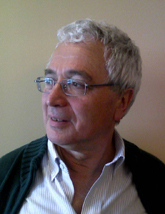 [completed 2010-04-08]
[completed 2010-04-08] Donald Knuth has said that Luis Trabb Pardo was his “right hand man” for the development of TeX78.
 [completed 2010-04-08]
[completed 2010-04-08]
Donald Knuth has said that Luis Trabb Pardo was his “right hand
man” for the development of TeX78.
Dave Walden, interviewer: Please tell me about your life before Stanford.
Luis Trabb Pardo, interviewee: I was born in Buenos Aires.
I began college studying engineering. The funny thing is that as soon as I started college I ran into a computer (an IBM 1620, paper tape and typewriter…) and the rest is history. In the late 1960s Argentina's military dictatorship had fired a great computer science group from the University of Buenos Aires, and nobody was left teaching any computer stuff. So some of us had to learn things by ourselves. I ended up teaching at the University (for which I had to finish my engineering degree), but I wanted to really learn computer science. So I applied for a Fulbright grant and ended up at Stanford.
DW: What year was that?
LTP: In 1973 I came to Stanford to get a PhD in computer science. Don Knuth was my advisor. I had a great time as a student. I think that my thesis was the last typewritten one at Stanford CS. After that all were electronically published.
DW: Your 1978 thesis was titled Set Representation and Set Intersection. Can you say a word about what it covered?
LTP: I presented a couple of ways to handle the very basic set operations (they are used in database processing). But then I stopped doing this type of work and moved into graphics and printing.
DW: What then?
LTP: After finishing my PhD I stayed working for Don (1978–1981), helping out with TeX. I had some sort of fancy sounding title such as “Associate Director, TeX Project”. I helped interfacing with people that were getting TeX.
DW: In one of his papers, Knuth says that “Luis Trabb Pardo was my right hand man” for TeX78. This apparently included being a reader for the theses of Michael Plass and Frank Liang, who both had Knuth as their thesis supervisor. You also co-authored a paper with Ignacio Zabala.
LTP: Ignacio rewrote the TeX SAIL implementation in Pascal. That was very important because SAIL was available only for DEC10/DEC20 machines while Pascal was widely available, especially in academic environments, where TeX was really wanted.
I did read those theses, but that is what you do while you are in Academia… And I did help Don interfacing with people that needed TeX. I would say that my most important contribution to TeX was to save Don's time.
I also worked on what could be done to print especially document proofs. At first there were no good page printers, except for the Xerox XGPs (three of them: Stanford, MIT, and CMU) so we interfaced Varian and Versatec electrostatic plotters (I still remember the kerosene smell). Then one day Canon showed up with a prototype laser printer (LBP-10) and I developed an interface for it. I remember the first time we showed it to outside people, and how hungry everybody was to be able to print beyond line printers and Daisy wheels.
DW: You are known for the Trabb Pardo-Knuth algorithm that was published in your 1977 paper “The Early Development of Programming Languages” with Knuth.
LTP: Don wanted to compare and honor the initial efforts to make computers programmable. And so we simply put together a tiny program that showed basic operations (expression evaluation, arrays, input output, etc.). The real challenge was to try to understand, and in many cases to extrapolate intentions from the little information that was left behind, since most of those language efforts were experiments and not widely used.
DW: What happened next?
LTP: I ended up leaving Stanford to start Imagen Corp., which built controllers and printers. TeX and troff were used to drive these printers. Later, desktop publishing started.
DW: Les Earnest from Stanford also was involved with Imagen, correct? I've also read somewhere on the Internet that Knuth was involved in Imagen.
LTP: Lester and I started Imagen and asked Don to join the Board. Don did it dutifully and cheerfully, and those meetings can be deadly boring. I always felt guilty about having Don spend time like that instead of doing the good work he does.
Since Imagen I have been working mostly on technology and architectures for very fast printing. I have started a series of three small companies: The Aurora Group I, II and III. Aurora III is still around. In all cases they developed technology embedded in printing systems. And I am still doing it.
DW: Do you have much remaining connection to TeX?
LTP: As I got more and more into printing, I got farther from TeX. But boy, it was fun to be part of the beginning of the wave of changes allowing production publishing on the desktop.
DW: Thank you for participating in our interview series.